Okra is one of India’s most healthy and favorite vegetables. Okra contains lots of proteins, vitamins, calcium, and minerals. Okra can grow in almost all Indian states, but most production is in Gujarat, West Bengal, Bihar, and Madhya Pradesh. The three main seasons of Okra growing occur from February-April, June-July, and October-November. Growing Okra plants is easy and great for beginner gardeners. Let’s check out the Okra plant growing stages.
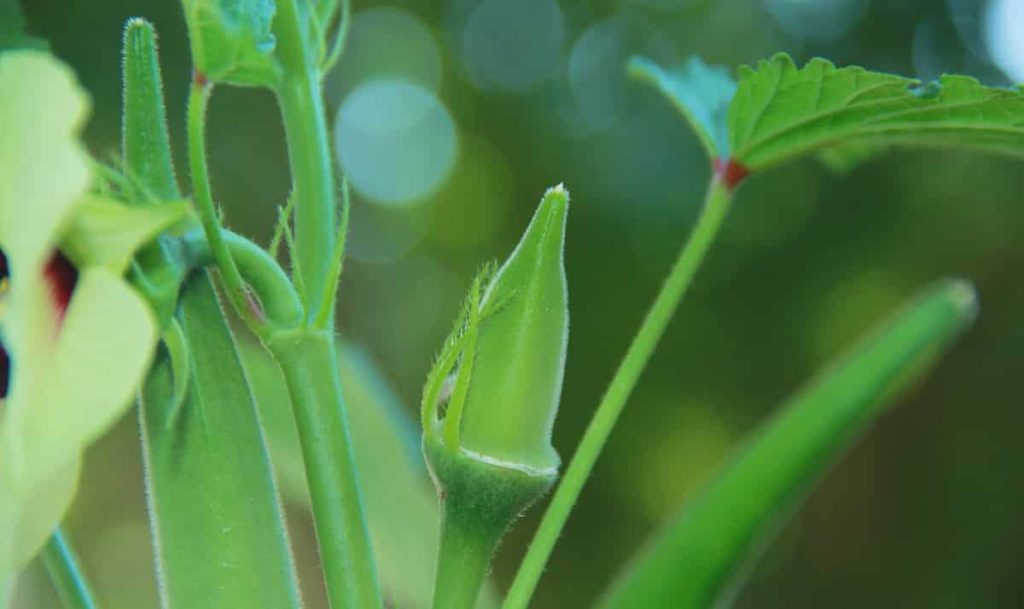
If you have an area with full sun, start growing Okra. It is a hot weather vegetable that will flourish. Apart from being simple to grow, the Okra does not take up a lot of space in the garden. It grows to 5 to 6 feet long, but it does not expand outside. So, as it moves long, lean, and upwards, you can maximize your space. The stalks are stiff and strong and produce a lot of pods per plant.
The Okra plant has linear and branched growth; palmate leaves contain five to seven lobes, and flowers are yellow or white, often with purple centers. Flowers give way to long seed pods, which are up to 7 inches long, with white seeds that fill the Pentagon-shaped chambered structure.
Necessaries for growing Okra in pots
A hot climate is best for growing Okra, and 25 to 35°C temperature is recommended during the crop. The Okra can grow in many soils, but the ideal soil is the sandy to clay loam with a good drainage facility and organic matter. If proper drainage is available, Okra can grow in heavy soil. Soil pH should be anywhere between 6.0 and 6.5. The potting soil is light and loose, and the topsoil will be packed down, interfering with drainage and root development.
You can use a soilless potting mix, including sphagnum peat, sand, and vermiculite, or modify organic matter with equal parts in the garden soil. Amending the garden soil rapidly with organic matter, sand, and vermiculite improves soil porosity and drainage. It is recommended that growing Okra in alkaline or salt soil should not be planned as these are soils with less drainage capacity.
In case you missed it: Best Fertilizer for Okra: Homemade, Liquid, Organic, Compost Manure, NPK, and Schedule
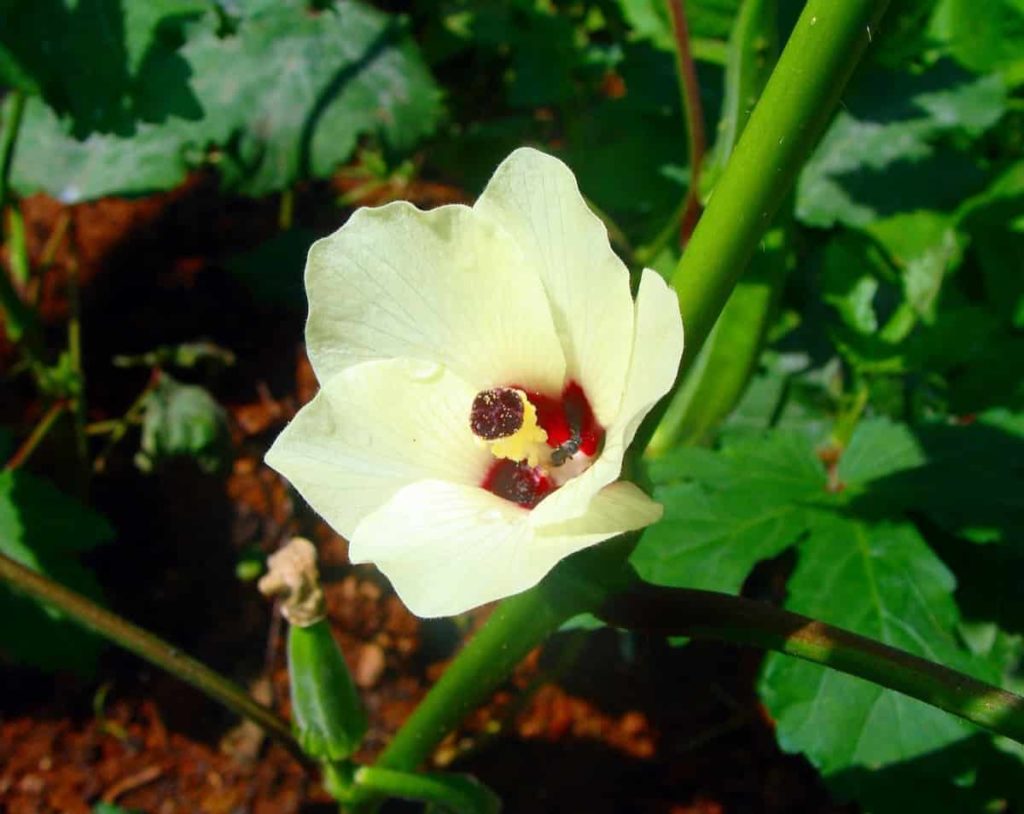
These fast-growing plants are strong feeders of nitrogen. Soil should be modified with organic matter and composted once again before planting and four weeks after sowing seed. The Okra should be given at least one inch per week of water. The soil can be thoroughly moistened with water every morning, except for heavy rain. Okra can withstand a little drought, but it is much better when given enough water during the summer. Ideal Okra types for containers are:
- Baby Bubba Hybrid
- Dwarf Blondy
- Cajun Delight
- Perkins Long Pod
Pot size for growing Okra
Growing Okra in containers means placing them on a courtyard, balcony, deck, and any small space outside your door. You may also have the advantage of putting them in ideal conditions. When you grow Okra in containers, you may have fewer critters and insects. In addition, the Okra has a tap root that likes to go deep. So, the bucket-type container works well for Okra plants.
A 20-liter container is suitable for the standard type, while the 15-liter container works fine for the dwarf variety. To grow Okra in pots, you can choose between pottery, recycled paint buckets, or an old recycled plastic bucket. Just use a small container (10 liters). It will ensure that the root system does not develop completely, and therefore the plant will not reach its proper height. But it will also reduce production.
Okra plant growing stages
Seed
An Okra pod can contain many seeds. There are about 15+ seeds per pod. And the technique of getting these high-quality seeds to plant is to ripen the pods. Make it in the most mature form. It will turn green and turn brown, which is in dry mode and produces quality seeds. Hybrid dwarf varieties of seeds are available these days, which grow only 2 to 3 feet. These are perfect for container gardening.
The stems can be challenging for them with a rough-haired feeling. Leaves are initially heart-shaped to mature the plant as well as to palmate. The Okra leaves are 4 to 8 inches long. Buds are formed on the leaf excel. Choose good quality seeds. We recommend buying seeds from a trusted supplier. Ask your friends about their experience, or start by observing user reviews if you are looking for online purchase.
In case you missed it: Okra Planting Frequently Asked Questions (FAQs)
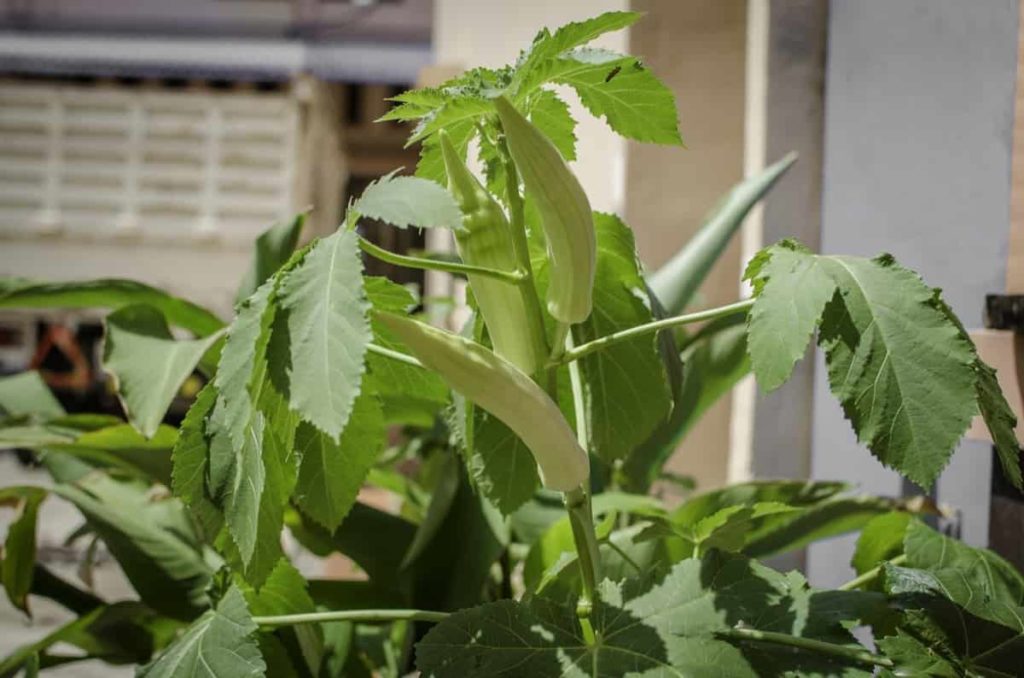
The Okra seed is small, round, smooth in texture, and green to dark green. These are the characteristics of the Okra seed. Dry, mature Okra seed is capable of growing. However, there are cases where seeds are very small, and the percentage of growth on such seeds is low. It should be fully mature and dry; best germination happens.
Germination
To grow seeds quickly and efficiently, soak seeds in water for about 8 to 10 hours. Use a cocopeat-based potting mix for sprouting seeds. Place the Okra seeds around 1.5 to 2 inches deep in the seedy tray. You can cover a seedling tray or pot with a plastic cover for faster germination. Make some small holes in the cover for airflow.
Keep the seeds growing in a hot place. In harsh weather conditions, you can also keep them indoors. The germination process takes a week to 10 days. It’s a summer crop but works well almost all seasons. Please wait for the plants to grow about 2 to 3 inches long and then transplant them into a large vessel.
- Sprouting stage– Seeds will grow within the first 6 to 8 days, and small sprouts will appear.
- Cotyledons – The first two leaves will emerge in the second week of germination.
- First leaves – The first leaves will emerge over the cotyledon the second weekend.
- Seedling stage – The seedlings will start growing in a small plant after the second week.
- Thinning – After the second week, place the single and healthy seedlings in one place, cutting the weak, small, and lagging seedlings with a pair of scissors.
Transplant
When the Okra seedlings have about two leaves (don’t count seed cotyledons), they are ready to have a transplant in the growing container. It should take about 30 days from the day seeds make the pot.
- Prepare the soil and fill your containers/pots.
- Be careful when removing the seedlings from the cups.
- Place the Okra seedling in the pot.
- Ensure that the seedlings are kept deep in the soil. If you plan to grow Okra plants in standard garden planters, give each plant 12 inches in diameter.
- Mix the soil to avoid the growth of weeds.
In case you missed it: Okra Growing Tips, Ideas, Secrets, and Techniques
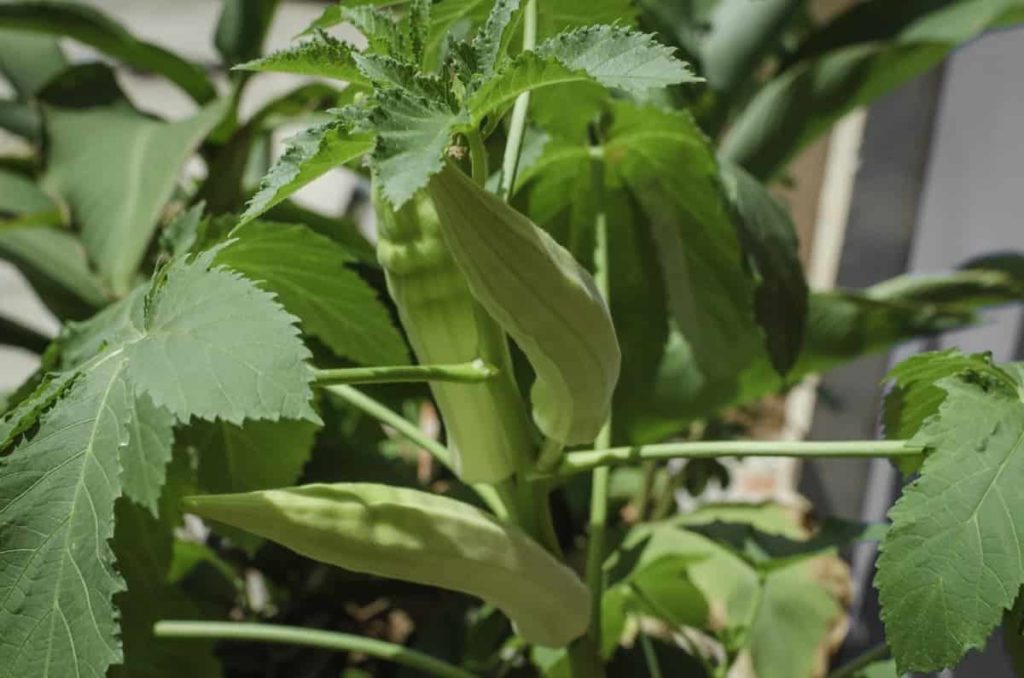
Young seedlings
Okra needs more care in this stage as their stems are very soft. Breaking is very easy, so you should take care of it with strong winds and animals. Okra seedlings are perfect when it has healthy germination. It will help if you water it regularly, especially when very hot. Cultivate soil around the seedlings and apply the pre-fertilizer application. This way, it can grow well. It can survive in its last place. Okra requires enough water to grow better.
Matured stage
Okra takes 50 to 65 days to grow and mature. If plants are getting sunlight, fertilizer, and proper water, they will continue to produce pods. If your season is growing longer, it means more Okra. The Okra began to make stiff leaves with more green leaves and strong stems in this stage. It will look the best Okra when it gets enough water, sunlight, and fertilizer. As a gardener, you should do your job to make it healthier.
They need more care than in the previous stages. You need to apply plenty of fertilizer and continuous water as it will produce a healthy and strong plant. Your efforts will force plants to produce more flowers and more pods in this stage. It would be best if you did it at this stage to don’t worry anymore after.
Once the plant reaches six inches high, re-add a dose of balanced fertilizer. If the soil is rich in nitrogen, adding balanced fertilizer can boost vegetative growth at the expense of fruit, so do what you can to maintain balance by keeping an eye on your pH level. Later in the growing process, you should feed the plant with fewer nitrogen fertilizers, such as 5-10-15, or 6-12-12, instead of a balanced mixture.
In case you missed it: Okra Seed Germination, Time, Temperature, Light

Flowering stage
This stage occurs when these flowers start blooming. The Okra is at 12 to 16 weeks or 3 to 4 months. In the meantime, the beautiful yellow smooth flower starts to show. This stage needs more fertilizer and water. You need to apply water every day because it is essential. You should also add fertilizer to be healthy. Organic fertilizer would be best for Okra. You also need to look for some insects that can attack your plants. Some insects can destroy your plants, so be aware of it.
Fruiting stage
This stage of Okra is when it starts producing pods for the first time. The characteristics of Okra pods are color is green when young and when grown, it is dark green. It has a smooth structure and a horizontal shape with pointed tips. Also, it can be about 4 to 8 inches long, depending on how much care you took. When the Okra starts to tolerate pods, it is already 3 to 4 months old. Some adjustments and improvements you should make. It will help in an excellent Okra pod bearing in the pot bounty.
Harvesting
The harvestable fruits of the Okra plant are the seed pods they produce about 60 days after planting time. It means that the Okra is quite mature. It’s perfect for harvesting. You can now get it when there is a hard pod in the Okra pod. It’s not that hard; the pods are quite mature but smooth. You should also find its color. A mature Okra pod should be green in color from yellow-green, indicating its maturity. It is quite a length and looks different than in previous weeks.
In case you missed it: Growing Okra Hydroponically from Seed; Planting; Care
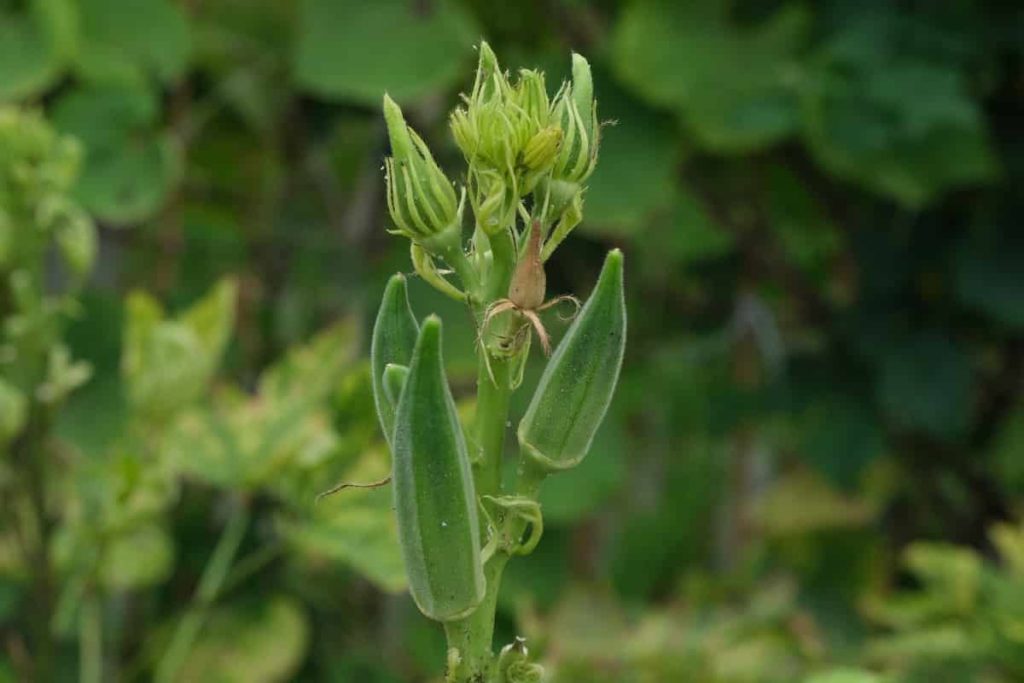
Okra plants have an excellent hibiscus-like flower before seed pod production, so it’s a significant indication of harvesting time. Harvest time comes very fast after blooming the plant. When harvesting Okra pods, you can either pinch the pods or use pruning shears to separate their trunks from the plant. Look for young pods two to four inches long for the softest fruits on average.
If allowed to grow from two to four inches, fruits can become wood, fibrous and unwanted. Harvest Okra pods every other day to boost continuous production. Okra plants can be hairy and spicy, which can cause skin irritation when bare skin. When harvesting seed pods, consider wearing garden gloves to avoid this painful event.
- How to Grow Tomatoes Organically at Home: A Comprehensive Guide
- Organic Gardening on a Budget: Low-Cost Methods and Materials
- Gongura Seed Germination and Planting Methods
- Cabbage Seed Germination and Selection
- Broccoli Seed Germination and Selection
- Asparagus Seed Germination and Variety Selection
- Seasonal Flower Gardening: Best Practices for Spring, Summer, Fall, and Winter
- How to Grow Hibiscus from Flower
- Plantation Ideas for Home Decoration: A Beginners Guide
- Flower Garden Designs and Layouts for Beginners
- Planting and Spacing Techniques in Papaya: A Beginner’s Guide
- Growing Gold: Essential Techniques for Planting Pineapples
- How to Make Kalanchoe Plant Bushy: Home Remedies and Solutions
- 11 Reasons Why Your Gardenia is Not Blooming: Home Remedies and Solutions
- Eco Elegance: The Guide to Designing a Drought-Tolerant Landscape
- Gardening on a Slope: Strategies for Hillside Landscaping
- Nourish and Flourish: Top Organic Mulches for Thriving House Plants
- Everything You Want to Know about Indian Mogra Flower: Discover Uses and Growing
- Green Thumb Success: Expert Tips for Cultivating Greenhouse Pumpkins All Year Round
- Maximize Growth & Flavor: The Ultimate Guide to Companion Planting in Herb Gardens
- How to Control Rhododendron Problems Naturally: Home Remedies and Organic Ways to Fix Them
- Natural Magic: The Remarkable Benefits of Cinnamon for Plants
- Best Steps to Revive Dying Tulip with Natural and Organic Treatment
- 10 Reasons Why Your Angel Trumpet is Not Blooming: Remedies and Treatment
- How to Fix Periwinkle Leaf and Flower-Related Problems: Natural Remedies and Solutions
- How to Fix Zinnias Leaf and Flower Problems: Discover Natural and Home Remedies
- Organic Steps to Induce Lemon Tree Flowers: A Comprehensive Guide
- Bloom Booster: Crafting the Perfect Homemade Bougainvillea Fertilizer
- Optimizing Growth: A Guide to Applying NPK Fertilizer for Potted Plants
- 10 Best Homemade Fertilizers for Rubber Plant: DIY Recipes and Application Method
- How to Boost Female Pumpkin Flowers: Effective Steps for More Flowers and High Yields
- Transform Your Indoor Garden: Top Benefits of Pink Salt for Houseplants
- 10 Best Homemade Fertilizers for Peacock Plants (Calathea): Easy DIY Guide
- Unlock Blooms: 9 Reasons Why Your Potted Chrysanthemum is Not Blooming
- 8 Reasons Why Your Potted Hibiscus is Not Blooming: Fix it with Simple Solutions
- Unlock Blooms: 9 Key Reasons Your Potted Frangipani Won’t Flower